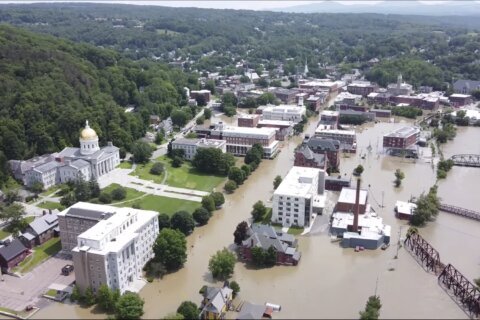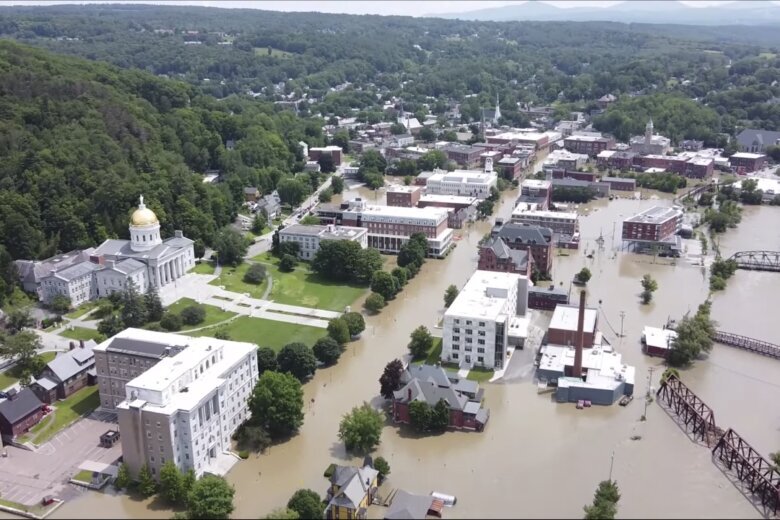
ANDOVER, Vt. (AP) — Volunteers pulled out their snow shovels Wednesday to clear inches of mud after torrential rain and flooding inundated communities across Vermont, trapping people in homes, closing roadways and littering streets and businesses with debris.
The water drained off most streets in the state capital of Montpelier, where the swollen Winooski River flooded basements and ground floors, destroying merchandise and furniture across the picturesque downtown. Other communities cleaned up as well from historic floods that were more destructive than Tropical Storm Irene in many places. Dozens of roads remained closed, and thousands of homes and businesses are damaged.
But with people still being rescued, high water still blocking some roads and new flash flood warnings issued with more rain on the way, the crisis is far from over, according to state Public Safety Commissioner Jennifer Morrison.
“Vermonters, keep your guard up, and do not take chances,” she said.
Morrison said urban search and swift water rescue teams came to the aid of least 32 people and numerous animals Tuesday night in northern Vermont’s Lamoille County, bringing the total to more than 200 rescues since Sunday, and more than 100 evacuations.
Volunteers turned out in droves to help flooded businesses in Montpelier, a city of 8,000, shoveling mud, cleaning, and moving damaged items outside. “We’ve had so much enthusiasm for support for businesses downtown that most of the businesses have had to turn folks away,” said volunteer organizer Peter Walke.
Similar scenes played out in neighboring Barre and in Bridgewater, where the Ottauquechee River spilled its banks, and in Ludlow, where the Black River sent floodwaters surging into several restaurants co-owned by chef Andrew Molen. He said Sam’s Steakhouse is likely closed for good after the water inside reached nearly 7 feet (more than 2 meters) high.
“The only thing that’s probably gonna be salvageable is the silverware, and even then, after being in that muck for so long, you wash everything, do you really want to put that on the table? It’s pretty intense what happened,” Molen said.
Another of his restaurants, Mr. Darcy’s, had a couple feet of water inside, damaging the foundation. But Molen said he hasn’t focused on cleaning up yet, because the first order of business has been making sure local residents and first responders stay fed. His crew has been cooking at one of the restaurants that remains functional and using ATVs through standing water to bring the meals to a local community center.
Gov. Phil Scott toured the disaster areas with Deanne Criswell, administrator of the Federal Emergency Management Agency, whose teams began aerial and on-the-ground damage assessments a day after President Joe Biden declared an emergency and authorized federal disaster relief.
The total cost of the damage could be substantial. According to to the National Oceanic and Atmospheric Administration, even before these floods, this year has seen 12 confirmed weather/climate disaster events with losses exceeding $1 billion in the United States.
“I think we all understand we are now living through the worst natural disaster to impact the state of Vermont since (the flood of) 1927,” U.S. Sen. Bernie Sanders said. “What we are looking at now are thousands of homes and businesses which have been damaged, sometimes severely. We’re looking at roads and bridges, some of which have been wiped out and will need basic and fundamental repairs.” The 1927 floods killed dozens of people and caused widespread destruction.
Scott said floodwaters surpassed levels seen during Tropical Storm Irene, which killed six people in Vermont in August 2011, washing homes off their foundations and damaging or destroying more than 200 bridges and 500 miles (805 kilometers) of highway.
Atmospheric scientists say destructive flooding events happen more frequently now because clouds carry more water as the atmosphere warms, and the planet’s rising temperatures will only make it worse.
New York ‘s Hudson River Valley also was hit hard, along with towns in southwest New Hampshire and western Massachusetts.
Massachusetts Gov. Maura Healey got a bird’s eye view in a helicopter ride to the small town of Williamsburg on Wednesday, where roads were washed out and some people had to be rescued from their homes. Even after two days of receding waters, the Connecticut River retained a muddy brown hue and farmland along the river remains saturated, she said.
Much of that water was carrying debris including entire trees, boulders and even vehicles south through Connecticut to Long Island Sound. Major waterways including the Connecticut River overflowed their banks, and were expected to crest Wednesday at up to 6 feet (2 meters) above flood stage, closing roads and riverside parks in multiple cities.
By mid-day Wednesday, all the rivers in Vermont had crested and water levels were receding, although at least one was 20 feet (6 meters) above normal, said Peter Banacos, a meteorologist with the National Weather Service. Thunderstorms, gusty winds and hail were forecast for Thursday and Friday in Vermont, but Banacos said they’ll blow through quickly enough that more flooding isn’t likely.
One death was blamed on the storm — a woman whose body was found after she was swept away in Fort Montgomery, New York.
About 12 Vermont communities, including the state capital, were under a boil water alert, but at least they were reachable again after being marooned by high water. The American Red Cross oftorrential rainweather Northern New England supported shelters in Rutland, White River Junction and Barre, where the city auditorium had 58 evacuees Wednesday morning, compared to more than 200 on Tuesday.
Many people were passing through to recharge their phones and get something to eat, said John Montes, regional disaster officer. Red Cross volunteers from across the Northeast were helping with disaster assessment and handing out clean-up kits to homeowners ahead of the next rains.
This flooding was catastrophic for Bear Pond Books, a 50-year-old store in Montpelier, said co-owner Claire Benedict. Water about 3 1/2 feet deep ruined many books and fixtures. Staffers and volunteers piled waterlogged books outside the back and front doors on Wednesday.
“The floor was completely covered with soaked books this morning,” she said as they cleared out the mud. “It’s a big old mess.”
Ludlow Municipal Manager Brendan McNamara said his town also suffered catastrophic damage. The water treatment plant was out of commission, the main supermarket and roadway through town were closed, the Little League field and a new skate park were destroyed and he said he couldn’t begin to estimate how many houses and businesses were damaged.
“We just really took the brunt of the storm,” McNamara said. But he said his town will recover. ”Ludlow will be fine. People are coming together and taking care of each other.”
___
Associated Press contributors include Kathy McCormack in Concord, New Hampshire; Pat Eaton-Robb in Hartford, Connecticut; Michael Hill in Albany, New York; and Mark Pratt, Michael Casey and Steve LeBlanc in Boston.
Copyright © 2024 The Associated Press. All rights reserved. This material may not be published, broadcast, written or redistributed.







